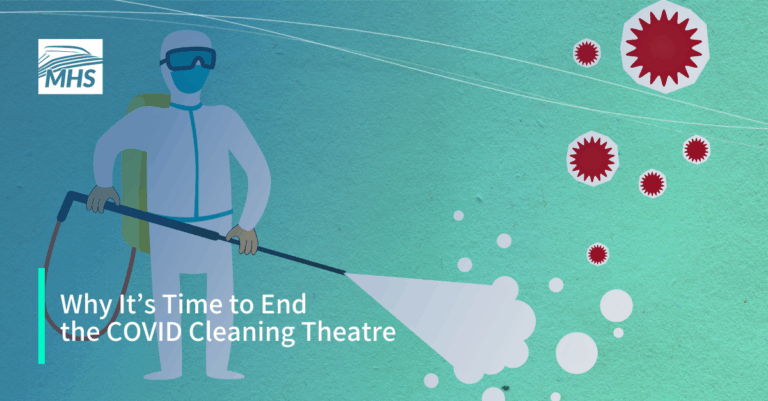As the cruise industry prepared to restart after its pandemic pause, it launched into a full-scale sanitizing spree. The approach was understandable. Early research warned that SARS-CoV-2 could linger on surfaces for days, prompting regulatory bodies like the CDC and EU Healthy Gateways to mandate rigorous cleaning and disinfection protocols.
Crew members got to work, as they always do. Luggage was wiped down. Incoming deliveries were disinfected. Housekeeping teams, clad in hazmat suits, fogged public areas and shuttle buses. No surface was spared. If fomites—those inanimate objects capable of carrying infectious agents—posed a threat, then sanitizing everything in sight felt like a way to regain control.
Today, four years later, many cruise ship outbreak plans still default to these enhanced sanitation measures whenever COVID-19 cases rise. The protocols often mirror norovirus response efforts, even though SARS-CoV-2 behaves very differently. The show goes on, in despite of mounting evidence confirming that surface transmission is rare.
Why, then, does this ritualized cleaning persist? And what is the true cost of keeping the performance alive?
What the Science Actually Says
The initial fear of contaminated surfaces wasn’t unfounded. A widely cited laboratory study circulated at the start of the pandemic showed that SARS-CoV-2 could survive on plastic and stainless steel for up to 72 hours. At a time of uncertainty, disinfection became a form of reassurance. It wasn’t just about hygiene; it was about optics.
By 2021, however, the scientific consensus had begun to shift. Dr. Emanuel Goldman, a microbiology professor at Rutgers University, published a commentary in The Lancet arguing that the risk of surface transmission had been greatly overstated.
He pointed out that laboratory studies demonstrating prolonged virus survival used unnaturally high viral loads, comparable to 100 people coughing onto the same surface. Under real-world conditions, he explained, the likelihood of fomite transmission was “very small,” typically confined to situations where someone coughs or sneezes directly onto a surface, followed by another person touching it within a short timeframe.
Subsequent research and updates from public health agencies reinforced this view. The CDC, for example, clarified that COVID-19 spreads primarily through respiratory droplets and aerosols, not via contaminated surfaces.
Yes, surface transmission is theoretically possible, but it doesn’t mean that it is a significant risk. It’s not the main route of infection, and everyday contact rarely delivers a viral load high enough to cause infection.
Complicating matters is the scientific caution against ruling out any transmission pathway entirely. Because the possibility of fomite transmission can’t be completely dismissed, some public health bodies—such as EU Healthy Gateways—have been slower to revise their formal guidance, even as the weight of evidence has shifted.
This evolving understanding didn’t eliminate the need for regular cleaning, but it did fundamentally reframe its role in infection prevention. Nevertheless, many cruise line protocols continue to treat surfaces as if they remain the primary threat.
Cleaning for Comfort, Not Control
If the science is clear, why do many cruise lines still cling to outdated routines?
Part of the answer lies in human psychology. Cleaning is highly visible. It projects diligence, control, and a commitment to guest safety. A freshly wiped handrail offers instant reassurance in a way that improved air filtration never could. And unlike widespread masking or social distancing, it doesn’t intrude on the guest experience.
Disinfection has become theatre. A performance that conveys, “We’re taking this seriously.” Over time, this performance hardened into routine. And like any ingrained habit, it has proven difficult to break.
But maintaining this hygiene theatre carries real costs.
Repeated disinfection of front and back-of-house areas drains one of a ship’s most valuable resources: crew energy. For staff tasked with nonstop sanitation efforts, the burden can be exhausting and demoralizing, especially when it does little to meaningfully reduce risk.
Then there’s the financial burden. The cost of disinfectants, fogging machines, and PPE quickly adds up. Meanwhile, the overuse of chemical agents—particularly during fogging operations—introduces new health concerns. Crew and passengers may be unnecessarily exposed to respiratory irritants and other hazards. Despite limited evidence of effectiveness, fogging remains widespread across the industry, even though experts agree it does little to prevent transmission unless preceded by thorough surface cleaning.
Perhaps most concerning is the message it sends. By doubling down on visible sanitation, we risk reinforcing outdated assumptions about how the virus spreads. This misplaced focus can erode trust in less conspicuous, but far more effective measures, such as improving ventilation, isolating cases, and promoting respiratory hygiene.
Good hygiene remains essential. But hourly surface disinfection is neither necessary nor impactful. The longer we continue the performance, the more we divert precious resources away from interventions that actually make a difference.
Closing the Curtain
It’s time to shift the spotlight. The fixation on surface cleaning isn’t just outdated; it’s a distraction from the strategies that truly protect people.
We don’t need more performances. We need smarter practices: rapid case identification, effective isolation protocols, improved ventilation, and education that builds health literacy among crew and guests alike.
This doesn’t mean abandoning cleaning. Routine cleaning remains important, but outbreak responses should be guided by evidence, not habit. As Dr. Goldman put it, “It is important to remain vigilant, but not waste resources on cleaning procedures that are not justified by the science.”
Letting go of the hygiene theatre isn’t about lowering standards. It’s about refocusing on the measures that actually reduce risk—and rebuilding trust in public health practices that make a real difference.
The future of safe cruising depends not on how much we can be seen to do, but on how effectively we act.

